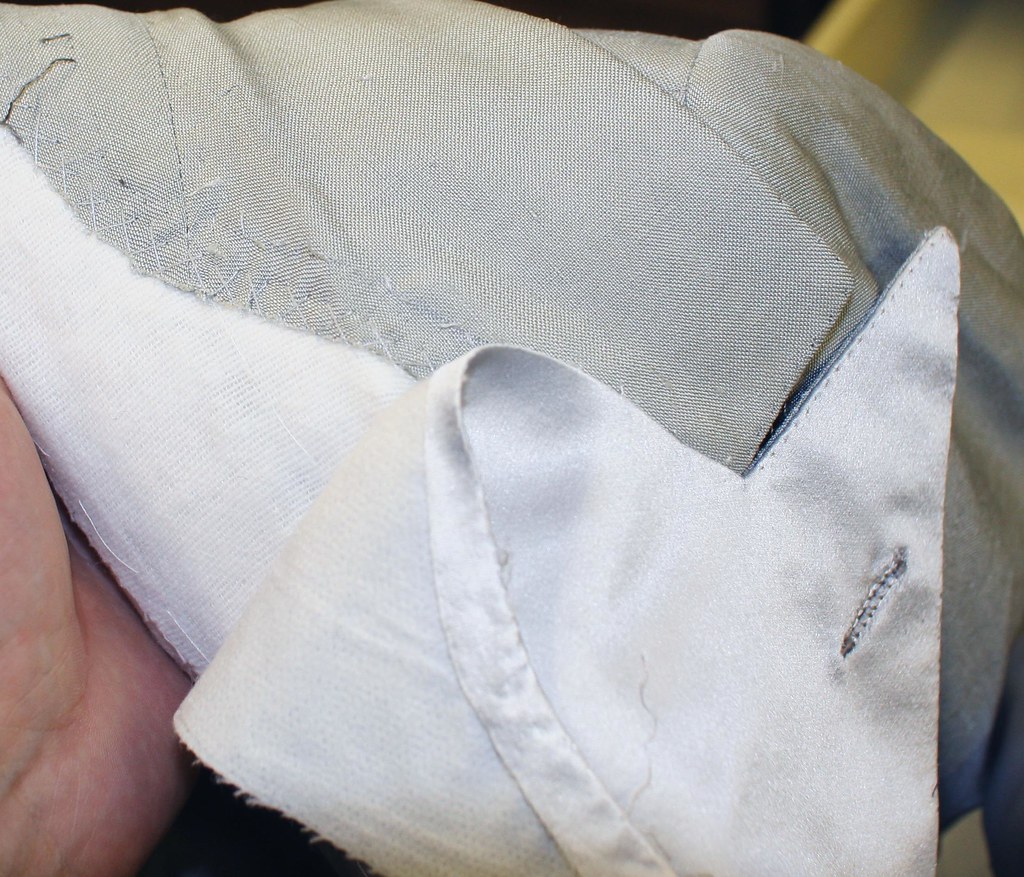Going back a bit again to the Brioni coat. This blogger may need Ritalin.
A curiosity here- the top collar is cross-stitched to the lapel by hand. What is a bit curious is that normally the top collar goes on AFTER the facing, but in this case it is clearly put on first. The facing must then be drawn on by hand. Which is curious in a factory setting. You may also notice that I have unpicked the lapel buttonhole to examine it more closely. This one needs some more research as to how they did it- I have seen this "upside-down" lapel buttonhole on some Zegna Couture, some Tom Ford, and some Neapolitan garments- the purl is much smaller and underneath the lapel making a very smooth, shiny buttonhole as though it had been done with a satin stitch and not a buttonhole stitch; the right gimp is crucial to this, I think. But back to the lapel sewing.
In a bespoke atelier where the shape of the lapel and position of the gorge may change during fittings, it is common to shape the lapel during the fitting, baste the seam allowances in place to check the result, and then fell them permanently to the canvas. The facing is then shaped with the iron, then basted on to the lapel, and slip-stitched in place. This is what we mean by hand-drawn; the gorge seam and the long lapel seam is sewn by hand. Here is an image from Sciamat's blog showing the process of sewing on the facing by hand.
In heavier cloth this is fine but lighter cloth will never be quite as crisp as a machine-sewn edge. The other disadvantage is that only the jacket seam allowance is felled- the facing seam allowance is free; when machining the edge, both seam allowances can be felled to the canvas making for a crisper, flatter edge. Regardless, even Oxxford, who prides themselves on doing absolutely everything by hand, sew the facing on by machine (at least on the garment I looked at) In a factory setting where the shape of the lapel is pre-determined I don't see any reason at all to sew this seam by hand- in fact, I think it is one of the few spots where machines give better results. But apparently Brioni has a reason to do otherwise.
I suspect it has to do with the silk facing and the fact that it may be very fragile; I will have to check but I would be surprised to learn they do all their production this way. I certainly would have noticed the ridge formed when doing the collar first, as they have here, so I am fairly confident that this is exclusive to their dinner jackets. What is also a little odd is that this sequence makes it impossible to finish the facing and linings flat; normally I like to have the side seams joined, then work the facings and linings on to the jacket flat on a table (where I will have more control, and as Sciamat are doing in the photo above) before joining the shoulder seam. Then the under collar is affixed, then the sleeves set, then the top collar, then the lining finishing.
The sequence here is a little different- first, the lapel is pad-stitched, then the edges are trimmed and turned then felled in place, then the flannel is applied to the lapel and then the side and shoulder seams joined; the collar can then be applied, both the undercollar and the top collar. Perhaps they then set the sleeves and finish by working on the facing and lining by hand, which is more difficult to do with a closed coat (rather than flat); this would avoid possible damage to the very delicate silk during the production cycle, as there are many opportunities to snag on machines, tables, and people.
All this extra work to preserve the delicate silk costs LOTS of money so the synthetic facing is now looking like a much more economical option, and most lay people probably wouldn't be able to spot the difference on a finished garment.
So once again the Brioni is splendidly made and delightful to look at and wear for the connaisseur; it is perhaps a bit like a wine novice spending hundreds (thousands?) on a bottle of Chateau Petrus- will he really appreciate it or would he be better off buying something more affordable which he will find equally pleasant? That is a question that only the consumer can answer for himself when making a purchase. It's all a question of budget and taste, I guess. На вкус и на цвет товарищей нет.








2 comments:
With yet another 'inside look' at clothing, you're well on your way to creating a book and DVD. Maybe it should entitled Outside In & Inside Out. Add a subtitle if you like. And wait for the book signing party to sip the Petrus.
JMB
A full course in tailoring. This is the reason I love your blog. You are really a teacher in these posts. I carry this information in different stages of knowledge, dwell on them, and do further research. I'm thankful you take the time to do this.
Post a Comment